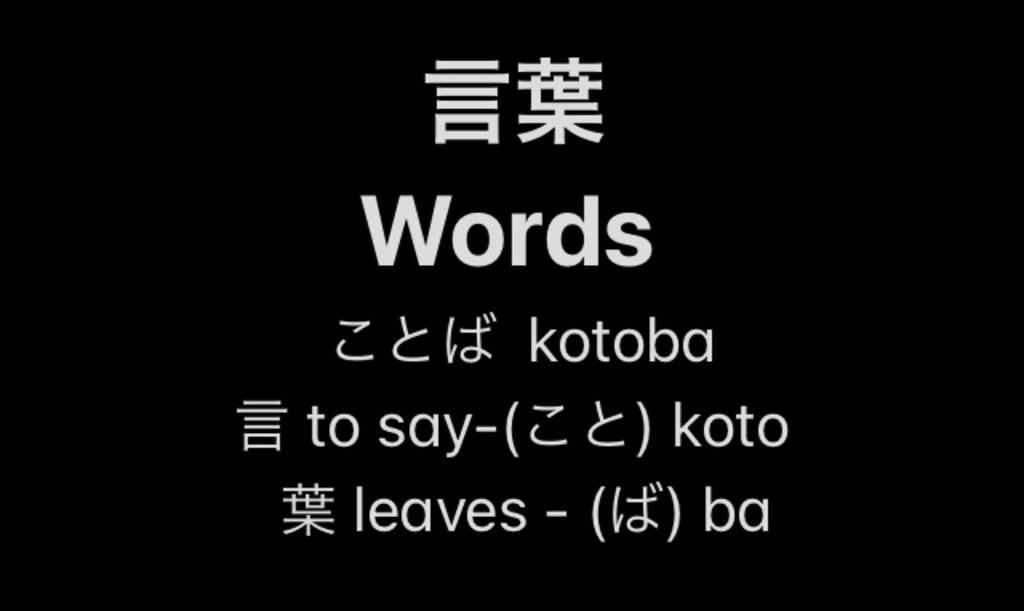Words are Spoken Leaves
Basics of Written Japanese

A short preface: When I look at the Japanese kanji characters for ‘word’ as pictured in the cover image, I imagine a story as a tree. The spoken or written words of the story are the leaves on the tree and they determine the type of tree, its shape, and the season we see it in. Japanese has been characterized as a vague language but its flip side is poetic and subtle. Written Japanese is for communication but it is also a calligraphic art discipline called shodo-the way of writing. The written language is a mixture of phonetic sound symbols (Hiragana, Katakana) and pictorial symbols (Kanji) that appeal to me as a visual artist. Put the three together and what should result in chaos becomes an organized, logical system. Learning the language and its written form has become a daily part of my life.

Several years ago, I tired of reading novels, biographies, and history books and chose to begin learning a language. I started with the shelf at my local library. I had had experience with French (due to moving, I had taken French I five times, another story). I took German (German I, twice), and Italian (while working for an Italian company in New York). A short one-semester stint with high school Japanese netted me the verb iku- to go. After perusing the language shelf, I chose a book on Latin and spent three weeks struggling until the book was due, then I tried Ancient Greek. This language was a bit more interesting because it had a different alphabet with some familiar characters and many words that have come to us in English. Again this interest only lasted until the book was due because I realized I would never talk to anyone using Ancient Greek. Then I took out the only Japanese language book on the shelf. After renewing it for six months, the librarian called me and said I had exceeded the limit for borrowing a single book! I was hooked and went out to buy it.
Japan has a depth and richness of language, a culture full of mysteries, history and a tradition of writing that goes far beyond Haiku poetry. The Japanese language is subtle and indirect, has complexities of formality and informality, ways of speaking divided by gender and social status or age of the people in the room. There are polite phrases and greetings expected far beyond please and thank you. There are also amusing homophones that lend themselves to wordplay. In addition, there are a few differences between the grammar of spoken and written Japanese, and differences between modern and ancient Japanese. I find learning the language endlessly entertaining. The initial challenge is not as difficult as it sounds.
Works of a few modern novelists such as Kafka on the Shore, The Wind-Up Bird Chronicle, by Haruki Murakami and Kitchen by Banana Yoshimoto have broken the language barrier in translation. But, like works by authors of other non-English speaking countries, these examples barely scratch the surface of what is available.
The nearest language school, for me, is a two-hour commute each way. I spent the first three years of my studies teaching myself the alphabet, reading with help from books, apps, and an online subscription course. When I could no longer progress further on my own after passing the lowest level JLPT (Japanese Language Proficiency Test), I began to commute to in-person classes offered by the Japan Society's Toyota Language Center in New York City.
My initial self-taught method of learning has had pros and cons. I know extensive and detailed vocabulary in the topics I am particularly interested in. My grammar and typical vocabulary learned in school, and the fluency that comes from speaking with other people could use more development. I am better at reading than speaking, but because I learned to read all three ‘alphabets’ at the same time, I have an easier time reading adult texts than beginner texts. These things work against me when taking timed beginner level progress tests such as the JLPTN5 that use Hiragana almost exclusively, but my unorthodox method of learning has kept me interested in progressing.
The Japanese language has two conventional writing layouts and uses three written alphabet systems in tandem. Traditional Japanese texts are vertical columns read from right to left from the 'back' of a book to the 'front'. It is also acceptable to write in the same format we use for English (horizontal lines read left to right). Commas and periods are used in much the same way as English, but possession and questions are marked with written partical syllables. Quotation marks are replaced with rectangular brackets and a partical syllable rather than a comma. A large dot is used to divide foreign words and names to help the reader. There are no spaces to differentiate between words in written Japanese. Instead, each word is marked at the end with a particle syllable that tells the reader whether the word is the sentence topic, the subject, object, direct object of a verb, and so on. The divisions of words and phrases are recognizable after a certain amount of study. Verbs almost always fall at the end of a sentence or phrase. I have learned as much about English grammar as Japanese during my studies.

In spoken Japanese, vowel sounds have little to no variation. If a double vowel occurs, the sound will be twice as long. Approximate sound equivalents to English are:
a; as in Sheba
i; as in she
u; as in suit
e; as in pen
o; as in potato
When combined vowels such as ou, ae, and ie occur, the vocalization of each letter is a separate sound.
Two of the alphabets are very easy to learn. The first alphabet, Hiragana, represents the phonetic basis of all Japanese words. It is the first writing system learned in school by children. Originally used primarily by women, Hiragana is a syllabary. These syllables make the writing system and reading easy for a beginner to learn. Once they are learned, entire hiragana texts can be read out loud even though the meaning might be unknown to the reader. A standard chart is written vertically, right to left. The first line, at the right, is organized by the vowel sounds a, i, u, e, o. Succeeding lines follow this pattern: ka, ki, ku, ke, ko; ma, mi, mu, me, mo, and so on. There are many free apps to help with the pronunciation and the stroke order for writing hiragana. It is of importance to include writing them by hand as they are studied. There is a disconnect between recognition of the shapes and reproducing them from memory by hand. There are practice books available, but I started with inexpensive composition books and later switched to lightly lined graph paper using four squares per character.

The second and most recent syllabary is called Katakana. Katakana symbols within a text are for the sole reason of transferring foreign words directly into Japanese phonetically. It contains all of the same syllables as Hiragana plus a few more compounds which allow the creation of sounds not found in the Japanese language.

Certain words are easily identifiable as English language derivatives, such as konputaa for a computer and nekutai for a necktie. Depending on nationality and language experience, some words can be more of a struggle, such as pan (bread) taken from the French pain. Other examples are arubaito (a part-time job), echoing the German word Arbeit, and buranko (a swing) taken from the Portuguese. Foreign city and country names follow this rule; Paris becomes pari, Rome becomes roma, the US becomes amerika, and France becomes furansu. Whenever you see Katakana in a sentence, you immediately know the word is from another country and reads phonetically.
There are several sounds found in English that do not transpose easily to Japanese. The most obvious of these is the l sound. In Japanese, this sound usually becomes a soft r. If you position your tongue at the top of your mouth as if you will make an l sound but make an r sound instead, you will create a fair approximation of the sound. V is another sound with a Katakana workaround. I recommend using learning videos by native speakers for pronounciation practice.
The third writing system is called Kanji. Kanji are pictorial characters that are said to have originated in China during the Han Dynasty (Kan- represents Han and -ji means character). I think of them as little pictures that tell a story. If someone from China and someone from Japan look at a character together, they will both generally understand the meaning of it, even though they use different words. An example: if an English speaking person and a French person look at a picture of a dog together, they both understand what it is, but one calls it dog and one calls it chien.
Roughly 2,000 kanji are in common usage in Japan (in China it takes knowledge of about 8,000 characters to read a text). Children begin to learn these Kanji in first grade and continue learning them through high school. The expectation for sixth-grade students is to recognize about 800 of them. Some kanji are easy to read and memorize because there is a visual relationship between the character and the object or idea it represents. Others are more complex. Complex kanji can be broken down into parts called radicals that give clues as to the meaning. Kanji characters can be combined to form more complex meanings.

Each kanji character can have one or more readings. There are two types of readings. ON readings are derived from the original Han Dynasty Chinese dialect. These readings almost always occur when two or more kanji characters appear together to form a word in a sentence. The other type of reading is kun reading. Kun readings follow the traditional native Japanese and are usually combined with Hiragana syllables to form words. Complex kanji characters are formed by writing several ideas together with a leading part, called a radical, to convey a new idea.
Below I have broken down the two kanji that together form 'word' in Japanese.


For readers interested in learning more of the Japanese language, I have compiled a resource list of books, websites and apps, many free or low cost, that were helpful to me when I began. The information included on this list is still available as of July 2021. I am not affiliated with any of the sites. To utilize some of the sites, you will need to add a Japanese character conversion to your smart phone, pad or computer keyboard. This is not difficult to do, but since it will vary between devices, the internet is the best place to look for instructions for your particular device.
For adult beginners and older children:
Books:
I don't enjoy cute pictures while learning, so these worked for me. Both were available at my local Barnes & Noble in the language section. Used copies are also available on Amazon.
Japanese Demystified Hard Stuff Made Easy by Eriko Sato published by McGraw Hill ISBN-13: 978-1259836251 ISBN-10: 1259836258
Essential Kanji: 2,000 Basic Japanese Characters Systematically Arranged for Learning and Reference by P.G. O'Neill published by Tuttle Publishing ISBN-13: 978-0834802223 ISBN-10: 0834802228
Websites:
A free desktop website with a plethora of information, links to other sites, and games by Charles Kelly. On my computer, I need to use the Java Script version as Adobe is not supported. A Japanese keyboard conversion is not needed for many of the quizzes, they are written in romaji. https://www.manythings.org/japanese/
A free desktop website with learning games for hiragana, katakana, kanji and a dictionary. You must create an account with a username to access the site. Tanoshii means fun in Japanese and the games are pretty fun. In addition, there is the satisfaction of climbing the ladder of success over other game users. https://www.tanoshiijapanese.com/home/
A free dictionary. https://jisho.org
Look up a kanji by the number of strokes used to write it. This is very useful when you come across a kanji and have no idea how to read it. Wikipedia also has a full page with history and usage for almost every kanji character. https://en.wikipedia.org/wiki/List_of_kanji_by_stroke_count
YouTube:
Japanesepod101 began as a podcast and has many free lessons to try. I also found their subscription service worthwhile before I began in person classes. The content is in Japanese and English. https://www.youtube.com/user/japanesepod101

The apps pictured above are good for more advanced beginners, although some sites on Instagram are great for beginning learners. Typing in #hiragana or #katakana should yield good results. Some Instagram learning accounts I recommend for advanced beginners are @dailyjapanesechallenge, @learn_japanese_with_videos, @easyjapanesee and @bunkai_shodo for clear instructions on how to write kanji characters.
The app labeled Japanese in the photo above is so useful I can't even begin to explain it. It's free. Its like a Swiss army knife. In search, type in a word, use your finger to draw, or look up a Kanji by radical. You can paste in text to look up the meaning. The reference section is full of useful information and has thousands of example sentences. You can save notes about words you are learning and use the flashcard decks to chart your vocabulary progress. You do need to add a Japanese keyboard to your phone to use this one, but it is not difficult. There will be instructions for your particular device online.
Let's Write Kanji. It is a memory writing game that involves reading a sentence and drawing the missing kanji character with your finger in a game of sudden death. You can also set it slower to beat the computer. This app is not suitable for complete beginners.
AsahiKanji costs a small amount but it has a flashcard for every kanji character. Choose to organize them into learning tiers either in the order Japanese students learn them in school or in the order they need to be learned for the JLPT- Japanese Proficiency Test given on the first Sunday in December in major cities across the United States and in many other countries.
Podcasts- NHK News has a podcast in Japanese which updates every hour. Each update is about five minutes long and contains breaking and current Japanese and international news.
NHK also has a desktop site that publishes current news stories formatted for Japanese children. You can read, listen to and watch videos of current events shortened and made easier to understand. Names of people, places and institutions are highlighted to make them stand out from the text. Kanji that would be difficult for an elementary student to read has furigana above. The reading level of the overall story is also categorized. There are links to the adult version of the story. New stories are added daily. The site also has directions on how to respond to weather events, tsunami and earthquakes. For English speaking students, some experience with the language is necessary. https://www3.nhk.or.jp/news/easy/
There are many other apps to explore. Usually the developers allow at least some beginner use for free. With some searching, you will find ones that fit your particular learning style.
A final note:
Speaking out loud is a very important aspect of learning a language. I recommend in-person learning for conversation and pointers on culture, manners and subtle nuances that can't be taught in a book. In the New York City area, the Japan Society is a great resource. Classes I attended had students living in three states. Students were between high school age and past retirement age. Each class had students of different nationalities who were attending for different reasons. All of the teachers are native Japanese. It was a wonderful experience which I intend returning to in the future. If you live in a more rural setting, consider hiring an online tutor. Even repeating dialog from videos out loud is helpful. Also check into opportunities at your local college or university. We have so many tools at our fingertips. A little effort brings amazing results!
**********************************************************************I hope you enjoyed learning about a language that has become a passion for me. I always love to see 'hearts', reads and even tips if you are so inclined. You can find me on Instagram at @maisonette_textiles where I occasionally attempt a sentence or two in Japanese and provide hashtags or translations using new vocabulary.
About the Creator
Natalie Wilkinson
Writing. Woven and Printed Textile Design. Architectural Drafting. Learning Japanese. Gardening. Not necessarily in that order.
IG: @maisonette _textiles






Comments
There are no comments for this story
Be the first to respond and start the conversation.